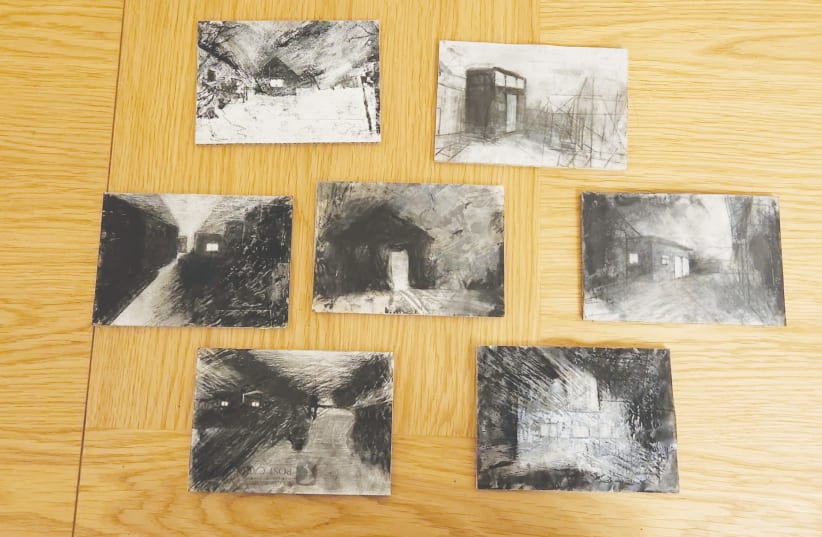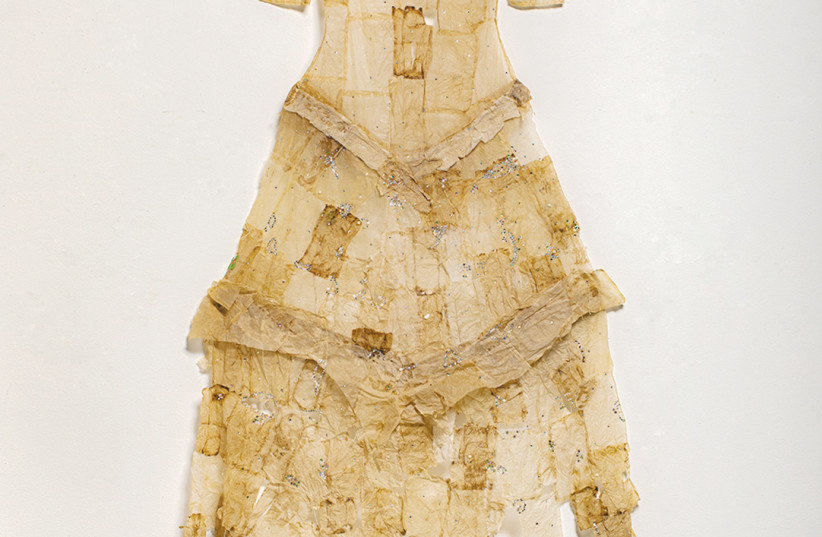Artists, in general, wear their hearts on their sleeves. A work of art, by definition, must be an expression of the artist’s feelings, even if they take an outwardly cerebral route to putting them over.
Ofira Oriel certainly airs her thoughts and emotions, but not just hers. On Tuesday, Oriel’s latest run-out will be unveiled to the public at Artists’ House in Re’ut, aka Modi’in-Maccabim-Reut. The common theme of all the works in the group exhibition is Esther (Etty) Hillesum.
To err somewhat on the side of generality and a smattering of pigeonholing, one could describe Hillesum as “an adult Anne Frank.” Both were Jewish Dutch women who were murdered by the Nazis. Both were writers, but basically the resemblance ends there. While Frank was just 15 when she was killed in Bergen-Belsen, Hillesum was around twice her age when she perished in Auschwitz. Frank would, no doubt, have matured over the years and, perhaps, would have mined philosophical seams similar to those explored by her older compatriot but, tragically, that will have to remain within the confines of conjecture.
The story of Esther (Etty) Hillesum and the Holocaust
Hillesum wrote confessional letters and – like Frank – diaries which chronicle her intimate and religious awakening and evolution, as well as the persecution of her coreligionists in Amsterdam during the Nazi occupation. Despite having numerous opportunities to save herself, she opted to remain incarcerated in Westerbork transit camp, together with her parents and her brother Mischa. All were eventually murdered in Auschwitz.
Oriel discovered Hillesum around 20 years ago, when she happened on a copy of the Dutch writer’s diaries, Het Verstoorde Leven (An Interrupted Life). That has had a profound impact on Oriel’s direction in life and her creative trajectory.
Her current showing follows a couple of previous solo exhibitions that fed off Hillesum’s life and her written musings and beliefs, which make for intriguing and enlightening reading. It was, says Oriel, just a matter of going with the flow. “It just felt right – the right thing at the right time – to read her. It gave me a different perspective on life. I had read all sorts of books about this kind of philosophy, but never before from someone who experienced such things firsthand. She went through some very tough experiences.”
Oriel says she finds inspiration in Hillesum’s approach to life and her ability to focus on the beauty around her, when it would have been so much easier and undeniably understandable to plummet to the depths of despair and lose all will to live. “I think she was a true heroine. She searched for the answers within herself, rather than looking to blame anything outside of her. That is an act of great courage of a chosen few. Not everyone can behave like that. It is not in our nature.”
In Oriel’s oeuvre, that capacity for seeing the joy, the divine and the life-affirming elements around us, through the challenging veils of misery and existential hardship, is partly conveyed through her choice of raw materials. The exhibits incorporate all sorts of flotsam and jetsam of everyday living, such as old scarred planks of wood and tea bags.
The tea bags are a central motif in the artist’s work, both as a base for the final product and as a part of the gestative process.
In the run-up to the Re’ut spread and her previous exhibitions, she spent time with Holocaust survivors at her mother’s sheltered housing facility, listening to stories and drinking tea.
“I ran the gamut of the process,” she chuckles.
“I want to disseminate her thoughts and philosophy as far and wide as I can. I am a firm believer in her way, her approach to life.”
Ofira Oriel
Oriel was, and still is, determined to get Hillesum’s story out, and her take on life in the most trying of circumstances. “I want to disseminate her thoughts and philosophy as far and wide as I can. I am a firm believer in her way, her approach to life.”
The tea bags are certainly front and center in the visual presentation in Re’ut. There are ink creations spread over groups of conjoined, overlapping, used tea bags, some abstract and others with clearly recognizable images of butterflies. Both fit the thematic bill.
“Etty liked drinking tea and she loved butterflies,” says Oriel, who puts her money where her admiration is, and now breeds butterflies herself, specifically the Old World Swallowtail variety.
The largest exhibit in Oriel’s slot is a dress, made of tea bags hanging on a nonindustrial-looking wire hanger.
“I wanted it to be self-crafted,” she says, reprising Hillesum’s tenet of discerning life’s gems among the apparent dross. “I would like people to come away from the exhibition with the ability to imbue meaning in seemingly insignificant things,” Oriel adds. “There is a sentence she wrote – I am paraphrasing a little here: in all this terrible situation in which we find ourselves now [during the Holocaust], we forget there is also the reality that can be found in the little cyclamen.”
Perhaps Hillesum was able to shut out all the darkness, at least for a while, but Oriel feels it is more a matter of accommodating the bad and the good and taking that as a given.
“It is like wabi-sabi,” she says, referencing the traditional Japanese concept of beauty which entails acceptance of imperfection and transience. “I think we should see the beauty in things that are tough, bent, torn, incomplete and broken. They have a lot of depth to them.”
Oriel manages to impart that sense of palpable subtext in her works, which include a set of postcards with monochrome ink pictures of small buildings.
“Yes, I got to the theme of houses, sort of archetypal Dutch houses,” she says. “And this one looks like a cupboard which, in a way, alludes to Etty coming out of the closet, in terms of her thinking, particularly with regard to religion.”
The exhibition is timely, not only because of the advent of Holocaust Remembrance Day, but it also follows the publication of the third edition of Het Verstoorde Leven in Hebrew, which includes 16 previously unpublished letters Hillesum sent from Westerbork.
“The last one was a postcard which Etty threw out of the cattle car of the train that was taking her to Auschwitz,” Oriel notes. The diminutive missive was duly delivered, and the public can now be privy to its contents. And emotive words they were, too. “In it she wrote to a friend ‘we left the camp [Westerbork] singing,’” Oriel adds. “There are no words to describe the feeling that evokes.”
Hillesum believed in a universal, noninstitutionalized take on faith rather than a specifically Jewish religious approach. “That’s probably why she is not so greatly admired in Israel,” Oriel suggests, bemoaning what she calls Yad Vashem’s less than enthusiastic attitude to Hillesum’s literary work. Perhaps that goes against the official Holocaust grain.
Be that as it may, Oriel’s exhibits are suitably emotive and attractive, particularly a sort of “scroll of independence” with fingerprints the artist obtained from all and sundry, including residents of her mother’s sheltered housing center, and which features a stirring quote from Hillesum’s writings: “After this war two torrents will be unleashed on the world: a torrent of loving-kindness and a torrent of hatred. And then I knew: I should take the field against hatred.” Sounds like good advice across the board these days, too.
For more information: https://www.ofiraoriel.com and Ofiraor@gmail.com













